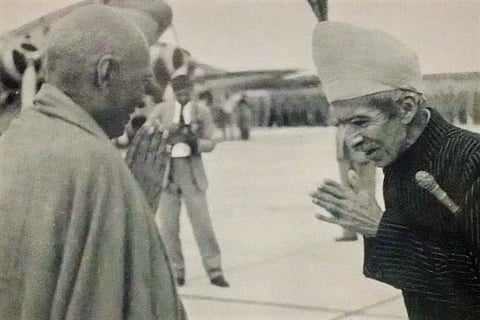

September 17 marks seventy years of Hyderabad's union with India. It was on this day in 1948, thirteen months after India gained independence that the state of Hyderabad ruled by Mir Osman Ali Khan, the seventh Nizam of the Asaf Jahi dynasty, surrendered to the Indian forces. But in the run-up to D-day, India and Hyderabad were engaged in a game of wits, both sides expecting the other to blink first.
On November 29, 1947 the Government of India signed a standstill agreement with the Nizam of Hyderabad, under which it was decided to give one year's time for both sides to arrive at an amicable solution. The Nizam privately hoped that he could continue as an independent ruler. Plan B was to make Hyderabad part of Pakistan.
But the tide started turning against the Nizam in the corridors of power in New Delhi with the exit of Lord Mountbatten from India in June 1948. The new Governor General C Rajagopalachari's missive arrived very soon after he took over. He wrote to the Nizam asking him to ban the Razakar movement and let the Indian forces be stationed in Hyderabad to take charge of law and order.
The Razakars had transformed from being volunteers of the Majlis to a private militia of sorts and accused of crushing any dissent against the Nizam by the freedom fighters. The militia was controlled by a lawyer from Latur called Qasim Rizvi, who wielded enormous power even though he held no official position in the Nizam's court.
Qasim Rizvi. Image: Wikimedia Commons
“The Government of India made the process official in August 1948, when it published a white paper listing out reasons why Hyderabad deserved tough action. It mentioned more than 300 incidents of atrocities allegedly committed since India's Independence by the Razakars,” says Mohammed Safiullah, historian.
In a parallel move, the military option was being given serious thought in New Delhi. The military commanders assessed that any resistance in Hyderabad could be overcome in a couple of weeks. The plan was to attack from two sides - the Sholapur-Hyderabad road and on the Bezwada (modern-day Vijayawada) to Hyderabad road. ‘Operation Polo’ was the code name given to the mission to add Hyderabad to the Indian Union, with the Indian forces proceeding towards the Deccan under the commandership of Major General JN Choudhuri.
The police action, a euphemism for military action started on September 13, 1948. It had been conveyed to the Nizam that should he put up a fight, there will be unnecessary bloodshed. That did not prevent the Razakars from taking on the Indian forces.
It took four days for Indian forces to reach the outskirts of Hyderabad. A Congress committee headed by Pandit Sunderlal that was subsequently set up, estimated that between 27,000 and 40,000 people were killed in the four days between September 13 and September 17, 1948, making it one of the bloodiest face-offs in independent India.
KM Munshi, India's Agent General in Hyderabad, was constantly working the phones with New Delhi, keeping Sardar Patel informed about the situation on the ground. On the afternoon of September 17, a messenger from the palace brought to Munshi a personal note written by Osman Ali Khan.
“Will you see me today at King Kothi Palace at 4 pm?” it read.
By the time Osman Ali Khan met Munshi, he had secured the resignation of Laiq Ali, the Prime Minister of Hyderabad. “The vultures have resigned. I don't know what to do,” the Nizam reportedly told Munshi. India's representative told the Nizam that law and order in Hyderabad remained top priority after its liberation.
Munshi next asked him to make a radio broadcast welcoming the police action and withdrawing his complaint before the UN Security Council. Safiullah points out that the Nizam had no clue how he was to record a radio address.
“’Broadcast? How is that done,’ the Nizam asked. The speech was drafted by Munshi for Osman Ali Khan, proof that India had taken over Hyderabad and that the King had faded into the past,'' says Safiullah.
Mir Osman Ali Khan. Image: Wikimedia Commons
That evening, the Nizam walked into the radio station for the first time in his life. With the Indian forces taking over his kingdom he had ruled since 1911, the Nizam's fall from grace was only too apparent. No red carpet was laid out for him at the radio station, no anthem was played. The Nizam rushed back to King Kothi palace after the broadcast.
A month later, Mir Osman Ali Khan issued a firman (edict) telling the people of Hyderabad that he was being treated well by the Government of India and he was not under any duress. For reasons best known to Osman Ali Khan, that was the only time he signed in English as ‘Nizam VII’.